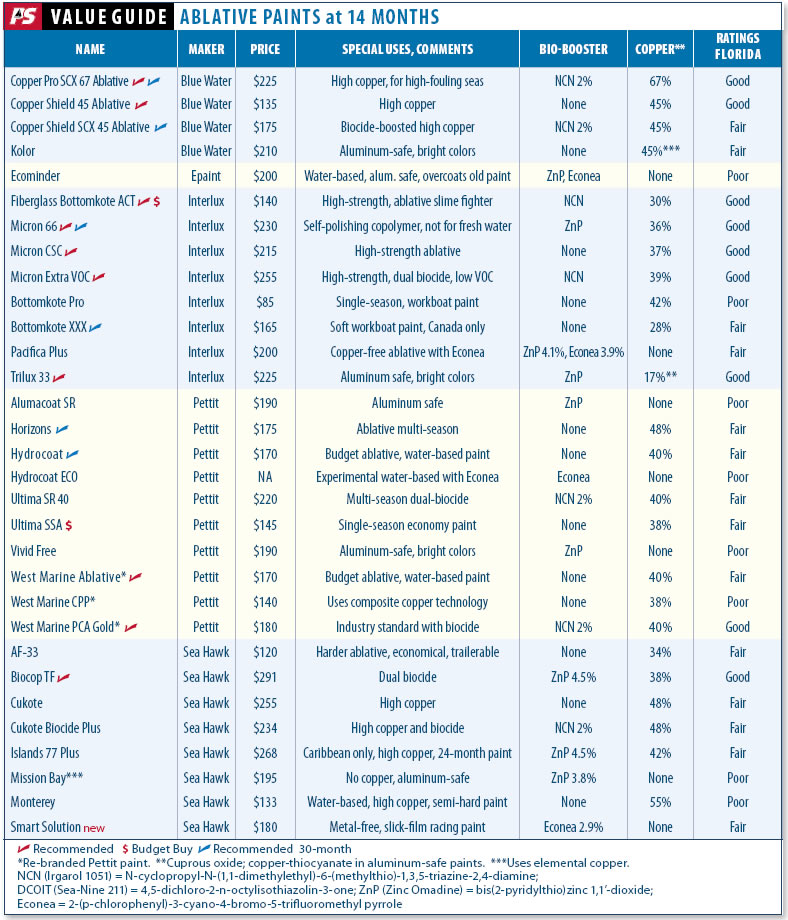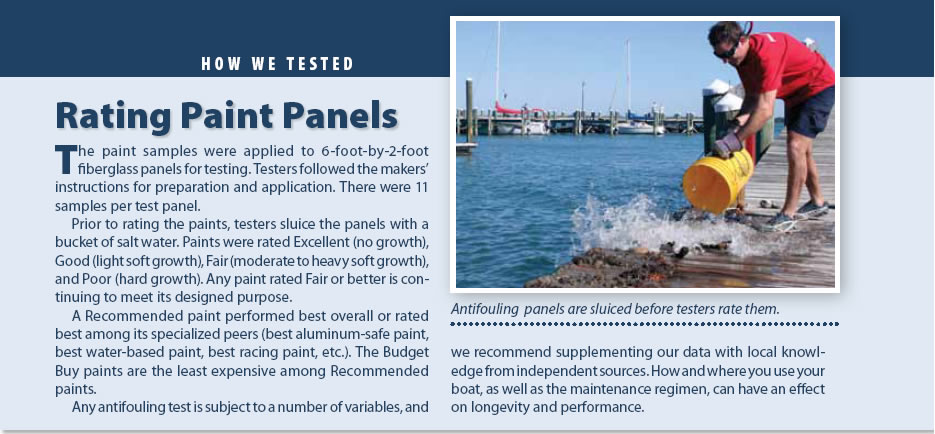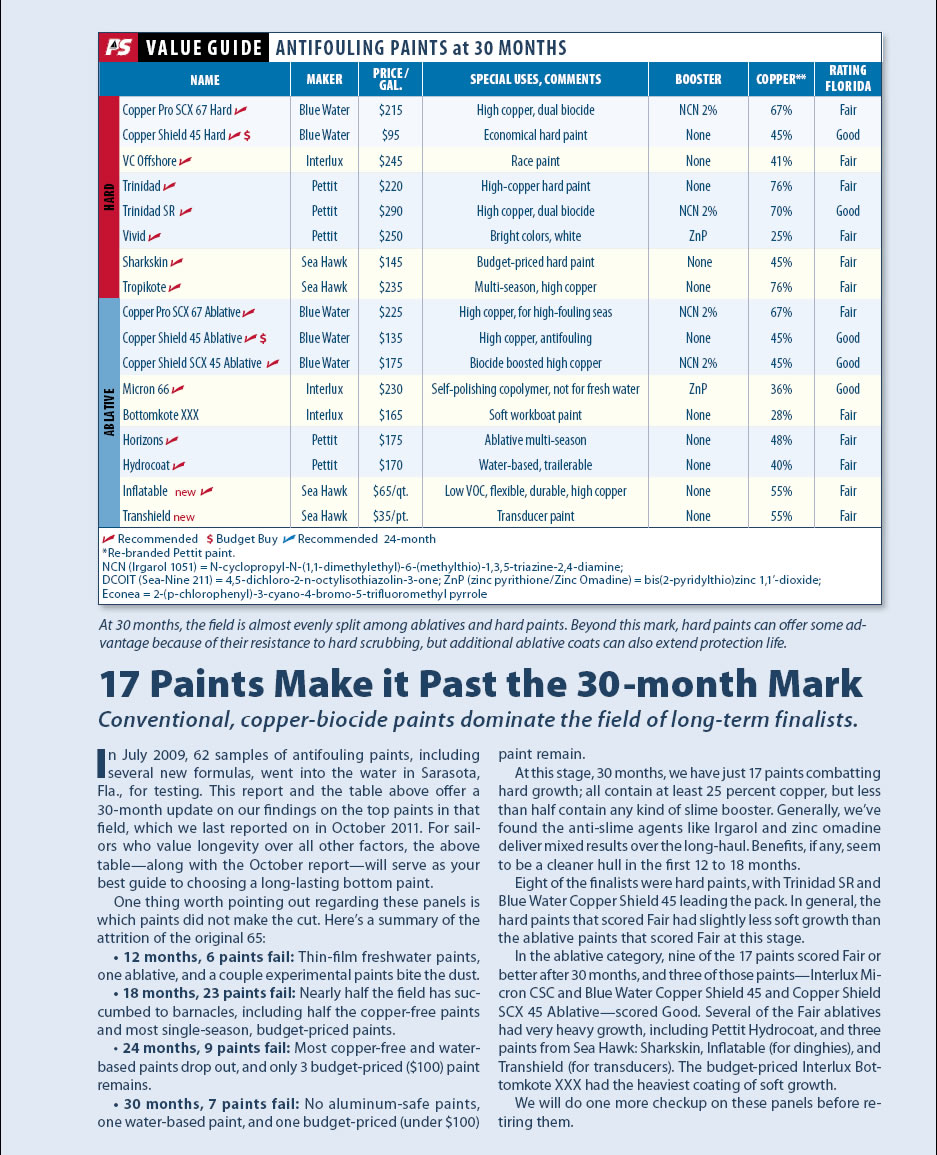
383
When we last reported on bottom paint, several manufacturers were introducing new copper-free paints in response to increased pressure from environmental groups and regulatory agencies, as well as to hedge against the rising price of copper. This trend continues as all of the major paint makers recently unveiled new paints designed to meet anti-copper legislation pending in California and scheduled to take effect in Washington state in 2018. Another key trend is the move toward water-based paints. These paints have low volatile organic compounds (VOCs), making it easier for manufacturers to meet new federal regulations for paint.
It’s still too early to judge the effectiveness of the newest formulas—we introduce these new paints on page 19—but we have had enough time to see how some of the antifouling paints introduced in 2010 are faring. At this point, results are mixed. Copper-free ablative paints containing the much-hyped biocide Econea—Interlux Pacifica Plus, Hydrocoat Eco (experimental), and Sea Hawk Smart Solutions—are barnacle-free at 14 months and holding their own with some conventional paints, but, in terms of slime protection, they aren’t matching the top-tier copper paints in the same price range. If you are interested in copper-free formulas, you have a few more effective options, but for long-term protection, conventional cuprous oxide formulas, or those using copper thiocyanate are still your best bet. Keep in mind, however, that the percentage of copper in a paint, particularly ablative-type paints, is not always a useful measure of comparison.
Finally, before you go changing paints, be sure to check compatibility with your existing paint. Most times, some light sanding, and possibly, a primer-coat is all you need to recoat your existing paint with an incompatible paint, but in some cases, a great deal of prep work is required.
What We Tested
Practical Sailor is simultaneously testing three panel sets: one that has been in the water 30 months, another that has been in the water 14 months, and a batch of 26 paints—mostly copper-free blends—that has just four months in the water. For details on the 30-month panels, see page 17. For an introduction of the new paints, see page 18.
This article focuses on the 14-month panels and is supplemented by the tables on pages 14 and 15. The panels comprises 56 different antifouling paints that PS began testing in November 2010 at the Sarasota Sailing Squadron in Sarasota, Fla. All panels were inspected in January 2012. The participating companies include Blue Water Paints, Interlux, Epaint, Pettit, and Sea Hawk.
The 14-month Value Guide tables are divided by paint category, hard and ablative. These two types of paint work differently, but for most boat owners, the key distinction is the maintenance regimen.
Hard paints hold up well to underwater cleaning and can usually be burnished smooth for racing. However, they leave behind resins and pigments that build up over time and eventually will need to be sanded off. Also, many hard paints lose their punch when they are stored out of the water for long periods, while most ablatives can be hauled and re-launched without worries.
Ablative paints wear away, so they don’t build up thick layers. There are two main types—bottom-tier workboat ablatives that slough away with water friction to activate more biocide, and more expensive copolymer ablatives that release biocides at a controlled rate. Some “hard” ablative paints resist light underwater cleaning and are suitable for trailering. Our four-month panel set includes some newer dual-resin ablative paints that claim even better resistance to abrasion.
Most paints are formulated for specific needs: freshwater paints, aluminum paints, racing paints, water-based paints (easy for the do-it-yourselfer to apply), and eco-friendly paints. The best performers in each of these subcategories earn a Recommended check mark in the Value Guides. Freshwater sailors should keep in mind that our saltwater test is particularly hard on freshwater paints, and these will do much better in lakes. Except where noted, all of our Recommended paints should perform the same or better in fresh water.
Blue Water
Based in North Brunswick, N.J., Blue Water Paints makes several general-purpose antifouling coatings that have fared well in our previous tests. It currently has five products still repelling barnacles on our 30-month panels. After 14 months of immersion, all of the Blue Water paints were free of hard growth. Its two copper-laden hard paints, Copper Pro SCX 67 Hard (boosted with the slime-fighter Irgarol) and Copper Shield 45 Hard earned Fair ratings; both are also doing well in our 30-month report. Its two cleanest ablatives were the Copper Shield 45 Ablative, a budget-priced ablative with no biocide and Irgarol-boosted Copper Pro SCX 67. These ablatives are also doing well in the 30 month test, along with Copper Shield SCX 45 Ablative. Blue Water Paints are also available at boatyards or from distributor Donovan Marine (www.donovanmarine.com) under the MarPro label.
EPAINT
Epaint specializes in copper-free paint, and several types have done well in PS tests over the long term. The company’s top-tier products are among the most expensive in our tests. Epaint 2000 and Epaint ZO have kept hard growth at bay for 24 months in past tests. This year, however, Epaint 2000 succumbed to hard growth at 14 months. This was the first time in several years that we have tested the gray instead of white EP2000, and because the paint is photoactive—releasing an inhospitable layer of hydrogen peroxide around the hull when exposed to sunlight—performance can vary slightly with color. The company’s other photo-active paints, Epaint ZO and Z0-HP (a high-performance racing paint), both white, were the two cleanest panels in the group. The company’s lone ablative in our test, Ecominder, was no longer active against barnacles in our test, though it did well in panel testing carried out by the San Diego Port Authority in 2010. For its photoactive paints, Epaint advises at least three coats in areas of the hull that see a lot of sunlight exposure. Not all Epaints are compatible with conventional paints, although the two overall best performers in this round— ZO and ZO HP—can safely be used over most hard antifouling paints.
Interlux
Interlux’s strongest performance came from its ablative paints, an area where the company has consistently done well. All but one of the ablative paints, the budget-priced Bottomkote Pro, repelled hard growth at 14 months. Five ablatives, Fiberglass Bottomkote ACT, Micron 66, Micron CSC, Micron Extra VOC, and Trilux 33 (the top-performing paint for aluminum-hulled boats), all scored Good. The copper-free Pacifica Plus, boosted with both Econea and zinc pyrithione is doing well, and the copper-loaded Ultra stands out among Interlux’s hard paints.
The other new paint in this test, the ablative Micron Extra VOC, was very clean, and seems to have lost none of the effectiveness in the switch to a more environmentally friendly formula.
Two Interlux paints were still fending off barnacles at 30 months, Micron 66, a consistent performer in our long-term tests, and Bottomkote XXX, a soft, sloughing, budget-priced workboat paint that is sold in Canada. Micron 66 is not recommended for freshwater lakes or rivers. The VC-17 series thin-film paints, aimed primarily at freshwater sailors and racers, succumbed to barnacles, as did the smooth, easy-to-wet-sand, hard racing paint Regatta Baltoplate.
Pettit/West Marine
Pettit, a Kop-Coat brand, competes alongside Interlux for the largest share of the recreational antifouling marketplace. The company also manufactures West Marine brand paint. As in our eight-month report, Pettit’s hard paints gave a very strong showing at the 14-month mark. Except for the budget-priced West Marine Bottomshield, which rated Fair, all of Pettit’s hard paints showed minimal slime, scoring Good or better. Pettit’s budget-priced hard paint, Unepoxy, showed only light biofilm. Pettit’s cleanest hard paint, Super Premium, has been discontinued but is still available in some stores. Pettit’s three copper-laden Trinidad products were also doing well, as they have in previous years.
In the ablative category, West Marine PCA Gold was the most impressive at 14 months with more than half the panel showing no slime at all. West Marine Ablative (formerly known as West Marine Pure Oceans and also sold as Pettit Hydrocoat), Horizons, Ultima SR 40, and Ultima SSA also held off barnacles. Horizons and Hydrocoat were the only two Pettit ablatives still barnacle-free on the 30-month panels. West Marine CPP, featuring what Pettit calls copper composite technology, is designed to promote extended protection with less copper. Three copper-free formulas, Alumacoat SR, Hydrocoat Eco, and Vivid Free, all showed significant slime and hard growth.
Sea Hawk
The conventional blends from Florida-based Sea Hawk paints consistently held barnacles at bay for 14 months, although like many makers, its eco-friendly blends suffered. Ablatives with additives dominated the field of top performers for Sea Hawk, with the Irgarol-laced Cukote Biocide Plus and two zinc-boosted paints, Biocop TF and Islands 77, having the cleanest panels. Of the three, Biocop TF was the cleanest, with only a thin layer of slime that easily rinsed away. The trailerable AF-33 and Smart Solutions, the only completely metal-free paint in the test, also repelled barnacles. Both, however, had moderate coats of algae that would require cleaning to remove. The copper-free Mission Bay and Monterey, a high-copper paint that has done well in previous tests, had clearly lost their potency. In the hard paint category, Tropikote outperformed the Irgarol-boosted Tropikote Plus, while the other surviving hard paints, Talon and Sharkskin, had fair-to moderate fouling that would require some scrubbing. The thin-film racing paint, Silver Bullet, like all the paints in this class, failed.
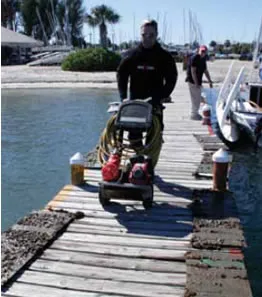
262
Conclusion
At 14 months, we begin to see two things: which paints keep your hull fast and smooth for a year, and which paints are likely to provide protection over the long term. Keep in mind that because we do not scrub or move our panels, you may see better performance over the short term. Because performance can vary with geography, we recommend consulting local experts, boatyards, and other boat owners to find what works in your area.
If you decide to clean the hull, take a conservative approach. Start with a sponge or T-shirt, and apply the least amount of pressure needed. If that doesn’t work, then move up to terry cloth. For even more muscle, move up to the green 3M scrub pad, a soft-bristle brush, or something similar. Once you need the scraper, it’s time to start planning a haulout.
Many ablative paints are designed to tolerate cleaning, but if you scrub hard at the outset, particularly on some softer ablative paints, you will literally be wiping your money away. Better to use the boat and let water action sluice the hull.
If you are using an ablative paint, you can also prolong the life of your protection by adding more than the recommended two coats. Some makers allow as many as four coats without risking adhesion problems. Check your manufacturer’s recommendations, and if you do use multiple coats, be sure to allow ample drying time.
Based on the performance of our 14-month panels, sailors looking for one to two years of protection against hard growth don’t need to pay a fortune. In the hard paints, Pettit’s Unepoxy and Blue Water Copper Shield 45 were Budget Buys. Pettit’s Unepoxy Plus and Copper Guard offer good value in the hard paint category. Blue Water’s Copper Shield 45 Hard is also a reliable low-budget contender. In the ablative category, there was a tie after 14 months, with Blue Water’s Copper Shield 45 Ablative ($135) and Interlux’s Bottomkote ACT ($140) offering the best value. Pettit Horizons and Sea Hawk AF-33 are also solid choices for the small-budget sailor.
For aluminum-friendly paints, any of the Epaint hard paints or Interlux Trilux 33 are the Best choices. Epaints ZO and Z0-HP were almost spotless, the cleanest of all the panels in this round of testing. Note, however, that none of the Epaints made it to the 30-month mark. If you go with the EP2000, a copper-free champ in past tests, opt for white. In general, do not expect more than 24 months of protection from any of the aluminum-friendly paints. These low-copper paints are also regarded as eco-friendly, and all of the makers have rolled out new lines of eco-friendly paints that we are watching. (See “New Paints for 2012,” on right.)
Among the racing paints, Epaint ZO-HP stood out as the cleanest, followed by Interlux’s VC Offshore. Vivid, because of its hard finish and bright colors, is also popular with racers. Sailors looking for easy-to-apply, water-based paints have their pick of two paints: Interlux’s Bottomkote Aqua, a hard paint, and West Marine Ablative (also sold as Pettit Hydrocoat).
Anyone stepping up past the $150 mark should see only minimal slime growth in the first year. This price range also includes the longer-lasting aluminum-friendly paints. If durability is most important, be sure to cross-reference your choice with the 30-month findings on page 17. Among the hard paints, Pettit’s Vivid, Trinidad, Trinidad SR, and Sea Hawk’s Tropikote stand out as potent, long-lasting coatings at both the 14-month and 30-month marks. In the ablative category, Micron 66, Blue Water Copper Pro SCX 67 Ablative, West Marine PCA Gold, and Sea Hawk Biocop TF are all good choices for clean bottoms at the 14-month interval.
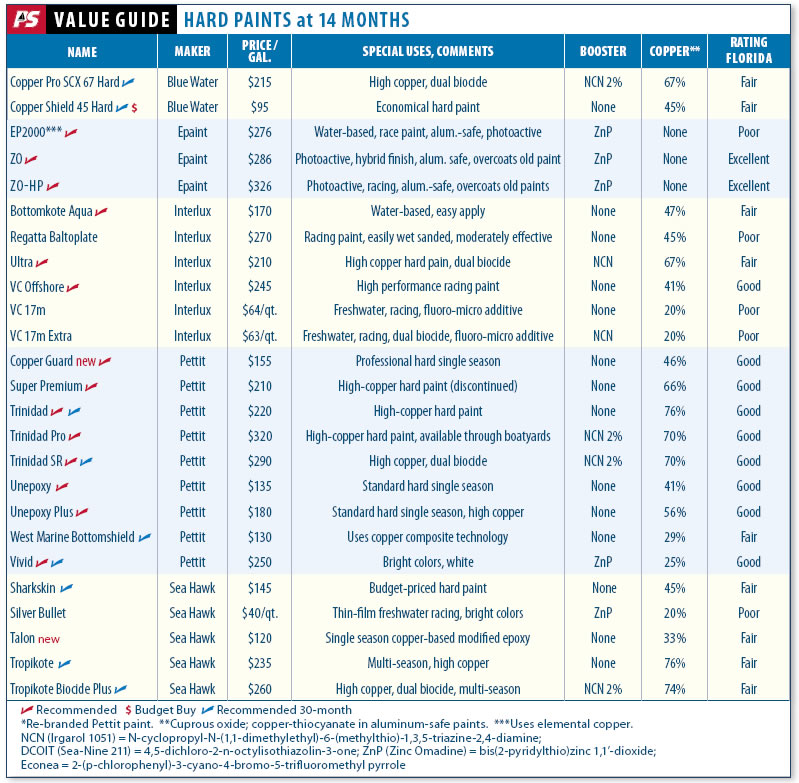
Checks indicate Recommended paints in one or more of five key categories—overall, aluminum-safe, water based, eco-friendly, and racing. Budget Buy paints are the least expensive of the Good paints. Prices are estimates and do not include shipping. Copper percentages are by weight, so paints with heavier solids in the resin may have more total copper, but a lower percentage.
